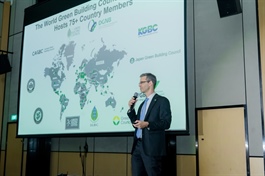Aviation industry anticipates upcoming growth period
Aviation industry anticipates upcoming growth period
Driving on growth momentum, air carriers in Vietnam are leaning into new plans to anticipate the next growth phase.
National flag carrier Vietnam Airlines on August 12 signed four strategic MoUs on aviation, tourism, and logistics with key South Korean partners to expand its step in the market.
According to the agreements, the airline will cooperate with South Korean companies in studying the establishment of a joint venture for aircraft maintenance, repair, and overhaul; developing cargo transportation; coordinating bilateral tourism promotion; and building inter-route tourism products.
The strong development of its international flight network is one of the notable highlights in the performance of Vietnam Airlines. As of July 1, it operates 69 routes to 37 destinations in over 20 countries, including strategic markets such as Italy, China, India, Japan, South Korea, and others.
“The effectiveness of the international flight network expansion strategy is clearly demonstrated when international transport revenue in the first half accounted for 60 per cent of total transport revenue, an increase of over 10 per cent over the same period last year,” said a representative from Vietnam Airlines.
The MoUs are part of the group’s strategy to expand its international footprint and to meet yearly targets. It has set specific goals for the second half of the year, such as operating 81,000 flights, transporting 13.1 million passengers, and achieving air transport revenue of $1.85 billion, all exceeding the initial annual plans.
General director Le Hong Ha said, “The last months of 2025 are an important premise for the corporation to enter the following years with many opportunities and goals to develop along with the transformation of the country. The airline is taking strategic steps towards a new stage of development.”
It is accelerating major projects, including one to invest in 50 new-generation narrow-body aircraft, with a total investment of more than $1.16 billion, expected to be implemented in 2030-2035. The initiative aims to improve operational efficiency, save fuel, and reduce carbon emissions.
At the under-construction Long Thanh airport, the group has kicked off many key undertakings, such as a ground equipment maintenance project, providing repair and maintenance services for aviation vehicles.
Digital transformation continues to be a strategic pillar in the coming period. Vietnam Airlines is collaborating with VNPT to deploy an in-flight internet connection service, helping passengers stay connected throughout their journey. At the same time, it is boosting system modernisation, service automation, and integration of electronic identification throughout the journey.
Similarly, budget carrier Vietjet is continuing to expand its fleet. In April, the company signed an agreement with AV AirFinance worth $300 million.
According to the airline, this is part of a series of financial agreements worth $4 billion that it has made with US partners to serve plans to develop a new fleet of nearly 300 aircraft, expected to be delivered by the end of 2027.
It is also focusing on expanding its international flight network to new routes, such as Nha Trang to Vladivostok, Khabarovsk, and Blagoveshchensk in Russia; Hanoi and Ho Chi Minh City to Beijing, Guangzhou, and Shanghai in China, and others to India and Japan. It is also boosting domestic flight numbers to Danang, Nha Trang, and Tuy Hoa.
Like Vietnam Airlines, Vietjet is also venturing further into airport investment. In July, the group received approval by the Ministry of Construction to build and operate aircraft maintenance services at the Long Thanh airport.
Expert Nguyen Thien Tong said, “The current moves of fleet expansion come from airlines’ expansion of their flights. This reflects the strong recovery of the aviation industry, which has quickly returned to the 2019 mark.”
Statistics from the Civil Aviation Authority of Vietnam have showed that in the first six months of this year, air transport recorded a recovery with passenger volume increasing by 9.1 per cent as compared to the same period last year, estimated at 59.7 million passengers.
Bamboo Airways has been attempting to keep pace with major changes and new strategies. The airline is optimistic about the possibility of reaching break-even point for core operations in 2025, creating an important premise for making future profit.
For 2025-2030, Bamboo is actively working with consulting partners and strategic investors to ensure the financial resources to anticipate the next growth phase.
“The opportunities open to Bamboo Airways are huge. We believe that it will soon find a strategic investor, achieve sustainable financial stability, and continue to grow strongly in the future,” said a representative.
Airlines improved their financial performance in the first half of this year. Vietnam Airlines has operated nearly 78,000 flights, transporting 12.6 million passengers and more than 165,000 tonnes of cargo in the January-June period, growing by 11, 13, and 15 per cent, respectively, over the same period last year.
Notably, its parent company gained $230 million, exceeding the plan by $108 million, a record in its air transport operations.
Vietjet made consolidated revenue of $1.43 billion and consolidated pre-tax profit of nearly $64 million, up 65 per cent on-year. The company operates 154 routes, including 109 international ones. It operated nearly 41,000 flights, served 7.5 million passengers, and transported nearly 29,000 tonnes of cargo during the period.
Bamboo Airways revealed it has a seat utilisation rate of 88 per cent. Revenues reached more than 96 per cent of the plan and operating losses decreased sharply, approaching the break-even point.
- 12:10 22/08/2025



























